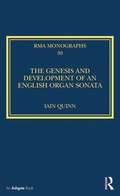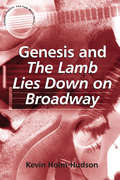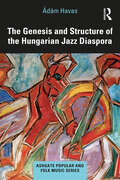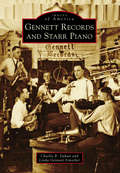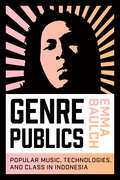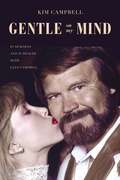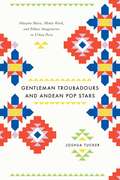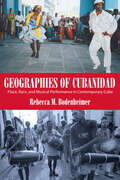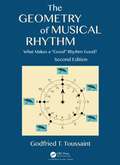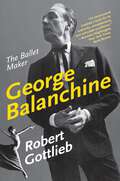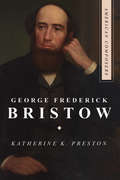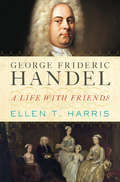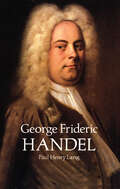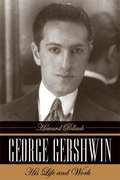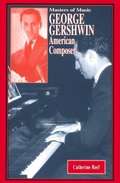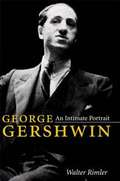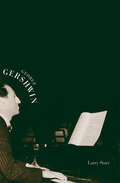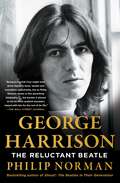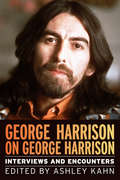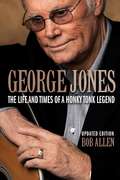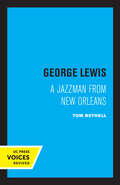- Table View
- List View
The Genesis and Development of an English Organ Sonata (Royal Musical Association Monographs)
by Iain QuinnThis volume considers the influences and development of the English organ sonata tradition that began in the 1850s with compositions by W. T. Best and William Spark. With the expansion of the instrument’s capabilities came an opportunity for organist-composers to consider the repertoire anew with many factors reinforcing a desire to elevate the literature to new heights. This study begins by examining the legacy of the keyboard sonata in Britain and especially the pedagogical lineage that was to be seen through Mendelssohn and ultimately the early organ sonatas. The abiding influence of William Crotch’s lectures are studied to illuminate how a culture of conservatism emboldened the organist-composers towards compositions that were seen to represent the ideals of the Classical era but in a contemporary vein. The veneration of Bach, Mozart and Beethoven is then examined as composers wrote "portfolio" sonatas, each with a movement in a contrasting style to exhibit their compositional prowess while providing repertoire for the novice and connoisseur alike. Finally the volume considers how the British organist-composers who studied at the Leipzig Conservatorium had a direct bearing on the furtherance of an organ culture at home that in turn set the ground for the seminal work in the genre, Elgar’s Sonata of 1895.
Genesis and The Lamb Lies Down on Broadway (Ashgate Popular And Folk Music Ser.)
by Kevin Holm-HudsonIn 1974 the British progressive rock group Genesis released their double concept album The Lamb Lies Down on Broadway. The story was described by Genesis's then front-man Peter Gabriel as a 'moral fable' about Rael, a half-Puerto-Rican New York City street tough who is engulfed by a solid cloud into a series of strange adventures in a metaphysical realm. The album is a surreal allegory drawing its material from religious, literary and psychological themes. More than thirty years after its release, The Lamb Lies Down on Broadway still enthralls listeners, earning the distinction of being Genesis's most consistently selling back-catalogue release. Kevin Holm-Hudson analyses The Lamb within the context of Genesis's recorded output, within the progressive rock genre as a whole, and within the context of social and political changes of the mid 1970s. The Lamb marked a conscious shift in their story setting to America, and for the first time the songs were oriented to the present rather than the past or future. Significantly, while 1974 marked the peak of music industry growth and consolidation through corporate mergers, it was also the year in which America was confronted with its limits: through the first of the OPEC energy crises, the resignation of Richard Nixon, the withdrawal from Vietnam, and the effects of runaway inflation. Genesis's native Britain was also to feel the effects of the energy crisis, intensified by a period of economic slowdown that ultimately led to the rise of Thatcherism. The Lamb is set in New York City during this time of uncertainty. Within a few years the economic constraints would affect the industry as a whole and as a result progressive rock would suffer a precipitous drop in industry support. The Lamb Lies Down on Broadway thus makes a particularly rich subject for detailed study, providing compelling intersections between the musical, textual and socioeconomic aspects of an album.
The Genesis and Structure of the Hungarian Jazz Diaspora (Ashgate Popular and Folk Music Series)
by Ádám HavasIn Hungary, jazz was at the forefront of heated debates sparked by the racialised tensions between national music traditions and newly emerging forms of popular culture that challenged the prevailing status quo within the cultural hierarchies of different historical eras. Drawing on an extensive, four-year field research project, including ethnographic observations and 29 in-depth interviews, this book is the first to explore the hidden diasporic narrative(s) of Hungarian jazz through the system of historically formed distinctions linked to the social practices of assimilated Jews and Romani musicians. The chapters illustrate how different concepts of authenticity and conflicting definitions of jazz as the "sound of Western modernity" have resulted in a unique hierarchical setting. The book's account of the fundamental opposition between US-centric mainstream jazz (bebop) and Bartók-inspired free jazz camps not only reveals the extent to which traditionalism and modernism were linked to class- and race-based cultural distinctions, but offers critical insights about the social logic of Hungary’s geocultural positioning in the ‘twilight zone’ between East and West to use the words of Maria Todorova. Following a historical overview that incorporates comparisons with other Central European jazz cultures, the book offers a rigorous analysis of how the transition from playing ‘caféhouse music’ to bebop became a significant element in the status claims of Hungary’s ‘significant others’, i.e. Romani musicians. By combining the innovative application of Pierre Bourdieu’s cultural sociology with popular music studies and postcolonial scholarship, this work offers a forceful demonstration of the manifold connections of this particular jazz scene to global networks of cultural production, which also continue to shape it.
Gennett Records and Starr Piano (Images of America)
by Charlie B. Dahan Linda Gennett IrmscherThe Starr Piano Company, based in Richmond, Indiana, quickly became one of the largest piano manufacturers in the United States during the 19th century. In 1915, the Starr Piano Company opened a recording division, Gennett Records, that led to a dynamic change in the music industry and American culture. Gennett embraced the vastly under-recorded genres of jazz, blues, and country music in the 1920s. They recorded artists who were groundbreakers and innovators in both popular and vernacular music, including Louis Armstrong, Charley Patton, Gene Autry, Hoagy Carmichael, Blind Lemon Jefferson, Uncle Dave Macon, and Jelly Roll Morton, often for the first time. The company, like many others, suffered a steep decline in the sale of their pianos and records due to the Great Depression, but the music recorded at Gennett continues to reach new generations and influence musicians as they discover it on reissues and streaming media services.
Genre Beyond Borders: Reassessing Operetta (Ashgate Interdisciplinary Studies in Opera)
by Bruno Bower, Elisabeth Honn Hoegberg, and Sonja StarkmethThis book offers an innovative approach to understanding operetta, drawing attention to its malleability and resistance to boundaries. These shows have traversed (and continue to traverse) with ease the national borders which might superficially define them, or draw on features from many other genres without fundamentally changing in tone or approach. The chapters move from nineteenth-century London and Paris to twentieth-century North America, South America and Europe to present-day Australia. Some offer fresh understandings of familiar composers, such as Johann Strauss or Gilbert and Sullivan, while others examine works or composers that are less well-known. The chapter on Socialist operetta in Czechoslovakia in particular will almost certainly be a revelation to anyone from Western Europe or the US, where operetta is often understood to be a bourgeois phenomenon. As a summary of the current state of the field, this collection showcases the many possible pathways for future scholars who wish to explore it.
Genre Publics: Popular Music, Technologies, and Class in Indonesia (Music / Culture)
by Emma BaulchGenre Publics is a cultural history showing how new notions of 'the local' were produced in context of the Indonesian 'local music boom' of the late 1990s. Drawing on industry records and interviews, media scholar Emma Baulch traces the institutional and technological conditions that enabled the boom, and their links with the expansion of consumerism in Asia, and the specific context of Indonesian democratization. Baulch shows how this music helped reshape distinct Indonesian senses of the modern, especially as 'Asia' plays an ever more influential role in defining what it means to be modern.
Gentle on My Mind: In Sickness and in Health with Glen Campbell
by Kim CampbellThe page-turning, never-before-told story of Kim Campbell's roller-coaster thirty-four-year marriage to music legend Glen Campbell, including how Kim helped Glen finally conquer his addictions only to face their greatest challenge when he was diagnosed with Alzheimer's disease.Kim Campbell was a fresh-faced twenty-two-year-old dancer at Radio City Music Hall when a friend introduced her to Glen Campbell, the chart-topping, Grammy-winning, Oscar-nominated entertainer. The two performers from small Southern towns quickly fell in love, a bond that produced a thirty-four-year marriage and three children.In Gentle on My Mind, Kim tells the complete, no-holds-barred story of their relationship, recounting the highest of highs—award shows, acclaimed performances, the birth of their children, encounters with Mick Fleetwood, Waylon Jennings, Alan Jackson, Alice Cooper, Jane Seymour, and others—and the lowest of lows, including battles with alcohol and drug addiction and, finally, Glen&’s diagnosis, decline, and death from Alzheimer's. With extraordinary candor, astonishing bravery, and a lively sense of humor, Kim reveals the whole truth of life with an entertainment giant and of caring for and loving him amid the extraordinary challenge of Alzheimer's disease. This is a remarkable account of enduring love, quiet strength, and never-faltering faith.
Gentleman Troubadours and Andean Pop Stars: Huayno Music, Media Work, and Ethnic Imaginaries in Urban Peru
by Joshua TuckerExploring Peru's lively music industry and the studio producers, radio DJs, and program directors that drive it, Gentleman Troubadours and Andean Pop Stars is a fascinating account of the deliberate development of artistic taste. Focusing on popular huayno music and the ways it has been promoted to Peru's emerging middle class, Joshua Tucker tells a complex story of identity making and the marketing forces entangled with it, providing crucial insights into the dynamics among art, class, and ethnicity that reach far beyond the Andes. Tucker focuses on the music of Ayacucho, Peru, examining how media workers and intellectuals there transformed the city's huayno music into the country's most popular style. By marketing contemporary huayno against its traditional counterpart, these agents, Tucker argues, have paradoxically reinforced ethnic hierarchies at the same time that they have challenged them. Navigating between a burgeoning Andean bourgeoisie and a music industry eager to sell them symbols of newfound sophistication, Gentleman Troubadours and Andean Pop Stars is a deep account of the real people behind cultural change.
Gentleman Troubadours and Andean Pop Stars: Huayno Music, Media Work, and Ethnic Imaginaries in Urban Peru (Chicago Studies In Ethnomusicology Ser.)
by Joshua TuckerExploring Peru’s lively music industry and the studio producers, radio DJs, and program directors that drive it, Gentleman Troubadours and Andean Pop Stars is a fascinating account of the deliberate development of artistic taste. Focusing on popular huayno music and the ways it has been promoted to Peru’s emerging middle class, Joshua Tucker tells a complex story of identity making and the marketing forces entangled with it, providing crucial insights into the dynamics among art, class, and ethnicity that reach far beyond the Andes. Tucker focuses on the music of Ayacucho, Peru, examining how media workers and intellectuals there transformed the city’s huayno music into the country’s most popular style. By marketing contemporary huayno against its traditional counterpart, these agents, Tucker argues, have paradoxically reinforced ethnic hierarchies at the same time that they have challenged them. Navigating between a burgeoning Andean bourgeoisie and a music industry eager to sell them symbols of newfound sophistication, Gentleman Troubadours and Andean Pop Stars is a deep account of the real people behind cultural change.
Gentle's Holler
by Kerry MaddenThe sixties may have come to other parts of North Carolina, but with Mama pregnant again, Daddy struggling to find work, and nine siblings underfoot, nobody in the Holler has much time for modern-day notions. Especially not twelve-year-old Livy Two, aspiring songwriter and self-appointed guardian of little sister Gentle, whose eyes' don't work so good yet. Even after a doctor confirms her fears, Livy Two is determined to make the best of Gentle's situation and sets out to transform the family's scrappy dachshund into a genuine Seeing Eye dog. But when tragedy strikes, can Livy Two continue to stay strong for her family?
Geographically Isolated and Peripheral Music Scenes: Global Insights and Perspectives
by Christina BallicoThis book explores the influence of geographical isolation and peripherality on the functioning of music industries and scenes which operate within and from such locales. As is explored, these sites engage dynamic practices to offset challenges resulting from geographical isolation and peripherality.
Geographies of Cubanidad: Place, Race, and Musical Performance in Contemporary Cuba (Caribbean Studies Series)
by Rebecca M. BodenheimerDerived from the nationalist writings of José Martí, the concept of Cubanidad (Cubanness) has always imagined a unified hybrid nation where racial difference is nonexistent and nationality trumps all other axes identities. Scholars have critiqued this celebration of racial mixture, highlighting a gap between the claim of racial harmony and the realities of inequality faced by Afro-Cubans since independence in 1898. In this book, Rebecca M. Bodenheimer argues that it is not only the recognition of racial difference that threatens to divide the nation, but that popular regional sentiment further contests the hegemonic national discourse. Given that the music is a prominent symbol of Cubanidad, musical practices play an important role in constructing regional, local, and national identities. This book suggests that regional identity exerts a significant influence on the aesthetic choices made by Cuban musicians. Through the examination of several genres, Bodenheimer explores the various ways that race and place are entangled in contemporary Cuban music. She argues that racialized notions which circulate about different cities affect both the formation of local identity and musical performance. Thus, the musical practices discussed in the book—including rumba, timba, eastern Cuban folklore, and son—are examples of the intersections between regional identity formation, racialized notions of place, and music-making.
The Geometry of Musical Rhythm: What Makes a "Good" Rhythm Good?, Second Edition
by Godfried T. ToussaintThe original edition of The Geometry of Musical Rhythm was the first book to provide a systematic and accessible computational geometric analysis of the musical rhythms of the world. It explained how the study of the mathematical properties of musical rhythm generates common mathematical problems that arise in a variety of seemingly disparate fields. The book also introduced the distance approach to phylogenetic analysis and illustrated its application to the study of musical rhythm. The new edition retains all of this, while also adding 100 pages, 93 figures, 225 new references, and six new chapters covering topics such as meter and metric complexity, rhythmic grouping, expressive timbre and timing in rhythmic performance, and evolution phylogenetic analysis of ancient Greek paeonic rhythms. In addition, further context is provided to give the reader a fuller and richer insight into the historical connections between music and mathematics.
George Balanchine: The Ballet Maker (Eminent Lives)
by Robert GottliebThe foremost contemporary choreographer in the history of ballet, George Balanchine extended the art form into radical new paths that came to seem inevitable under his direction. He transformed movement and dance in classical and modern ballet, on the Broadway stage, and in the cinema.George Balanchine chronicles the life and achievements of this visionary artist from his early, almost accidental career in Russia, where his lifelong collaboration with Igor Stravinsky was forged, to his extraordinary accomplishments in America. The editor and writer Robert Gottlieb, one of the most knowledgeable dance critics in America, offers a superb and loving portrait of a genius who, though married many times to many ballerinas, remained truest to his greatest love, Terpischore, the Greek Muse of dance.
George Frederick Bristow: Symphony No. 2 In D Minor, Op. 24 ( Jullien ) (American Composers)
by Katherine K. PrestonAs American classical music struggled for recognition in the mid-nineteenth century, George Frederick Bristow emerged as one of its most energetic champions and practitioners. Katherine K. Preston explores the life and works of a figure admired in his own time and credited today with producing the first American grand opera and composing important works that ranged from oratorios to symphonies to chamber music. Preston reveals Bristow's passion for creating and promoting music, his skills as a businessman and educator, the respect paid him by contemporaries and students, and his tireless work as both a composer and in-demand performer. As she examines Bristow against the backdrop of the music scene in New York City, Preston illuminates the little-known creative and performance culture that he helped define and create. Vivid and richly detailed, George Frederick Bristow enriches our perceptions of musical life in nineteenth-century America.
George Frideric Handel: A Life with Friends
by Ellen T. HarrisAn intimate portrait of Handel's life and inner circle, modeled after one of the composer's favorite forms: the fugue. During his lifetime, the sounds of Handel's music reached from court to theater, echoed in cathedrals, and filled crowded taverns, but the man himself--known to most as the composer of Messiah--is a bit of a mystery. Though he took meticulous care of his musical manuscripts and even provided for their preservation on his death, very little of an intimate nature survives. One document--Handel's will--offers us a narrow window into his personal life. In it, he remembers not only family and close colleagues but also neighborhood friends. In search of the private man behind the public figure, Ellen T. Harris has spent years tracking down the letters, diaries, personal accounts, legal cases, and other documents connected to these bequests. The result is a tightly woven tapestry of London in the first half of the eighteenth century, one that interlaces vibrant descriptions of Handel's music with stories of loyalty, cunning, and betrayal. With this wholly new approach, Harris has achieved something greater than biography. Layering the interconnecting stories of Handel's friends like the subjects and countersubjects of a fugue, Harris introduces us to an ambitious, shrewd, generous, brilliant, and flawed man, hiding in full view behind his public persona.
George Frideric Handel (Dover Books On Music: Composers)
by Paul Henry Lang"I was so impressed by what Dr. Lang has done in his new and very fresh approach to Handel, his life and works, that I can find only one word to express my feeling about it: Monumental!" -- Eugene Ormandy.Universally known and admired for his great oratorio Messiah, George Frideric Handel (1695-1759) ranks among the greatest composers of all time. Over a career of more than 50 years, most of it spent in England, the German-born master composed numerous other oratorios, operas, concertos, chamber music, orchestral suites, cantatas, and more. But until now, far less has been known about the man "possessed of a central calm" but whose "driving force was incalculable."In this immensely thorough and readable biography -- considered by many scholars the definitive work on Handel -- renowned musicologist Paul Henry Lang penetrates the mystery of Handel's life to paint a vivid portrait of the great composer, while offering expert analysis of Handel's music -- its sources, nature, forms, and influence.Detailed, meticulously researched discussions cover Handel's birth and childhood in Halle; his early musical training and years at university; sojourns in Italy and meetings with Corelli, Scarlatti, and other major composers; Handel's adoption of England as his home; his business dealings in London; his somewhat puzzling relations with women; the onset of blindness in 1751 and the end of his artistic career; his death in 1759 and burial in Westminster Abbey; and many other aspects of his long and complex life.In addition to the breadth of biographical material, Dr. Lang offers detailed discussions of Handel's music, of both its general characteristics and the specific features of such masterworks as the oratorios Messiah, Israel in Egypt, Solomon and Judas Maccabaeus; the operas Giulio Cesare and Rinaldo; the orchestral suites Royal Fireworks Music and Water Music;the pastoral Acis and Galatea; the odes Alexander's Feast and Ode for St. Cecilia's Day; and many other compositions. Perceptive, extremely thorough and obviously a labor of love, this masterly biography belongs in the library of every musician, music lover, and student of music and music history.
George Gershwin: His Life and Work
by Howard PollackThis comprehensive biography of George Gershwin (1898-1937) unravels the myths surrounding one of America's most celebrated composers and establishes the enduring value of his music. Pollack's lively narrative describes Gershwin's family, childhood, and education; his early career as a pianist; his friendships and romantic life; his relation to various musical trends; his writings on music; his working methods; and his tragic death at the age of 38.
George Gershwin: American Composer
by Catherine ReefTraces the life of the American Jewish composer who created a new kind of music that has lasted beyond the fashion of his time.
George Gershwin: An Intimate Portrait (Music in American Life)
by Walter RimlerGeorge Gershwin lived with purpose and gusto, but with melancholy as well, for he was unable to make a place for himself--no family of his own and no real home in music. He and his siblings received little love from their mother and no direction from their father. Older brother and lyricist Ira managed to create a home when he married Leonore Strunsky, a hard-edged woman who lived for wealth and status. The closest George came to domesticity was through his longtime relationship with Kay Swift. She was his lover, musical confidante, and fellow composer. But she remained married to another man while he went endlessly from woman to woman. Only in the final hours of his life, when they were separated by a continent, did he realize how much he needed her. Fatally ill, unprotected by (and perhaps estranged from) Ira, he was exiled by Leonore from the house she and the brothers shared, and he died horribly and alone at the age of thirty-eight. Nor was Gershwin able to find a satisfying musical harbor. For years his songwriting genius could be expressed only in the ephemeral world of show business, as his brilliance as a composer of large-scale works went unrecognized by highbrow music critics. When he resolved this quandary with his opera Porgy and Bess, the critics were unable to understand or validate it. Decades would pass before this, his most ambitious composition, was universally regarded as one of music's lasting treasures and before his stature as a great composer became secure. In George Gershwin: An Intimate Portrait, Walter Rimler makes use of fresh sources, including newly discovered letters by Kay Swift as well as correspondence between and interviews with intimates of Ira and Leonore Gershwin. It is written with spirited prose and contains more than two dozen photographs.
George Gershwin
by Larry StarrIn this welcome addition to the immensely popular Yale Broadway Masters series, Larry Starr focuses fresh attention on George Gershwin's Broadway contributions and examines their centrality to the composer's entire career. Starr presents Gershwin as a composer with a unified musical vision--a vision developed on Broadway and used as a source of strength in his well-known concert music. In turn, Gershwin's concert-hall experience enriched and strengthened his musicals, leading eventually to his great "Broadway opera,"Porgy and Bess. Through the prism of three major shows--Lady Be Good(1924),Of Thee I Sing(1931), andPorgy and Bess(1935)--Starr highlights Gershwin's distinctive contributions to the evolution of the Broadway musical. In addition, the author considers Gershwin's musical language, his compositions for the concert hall, and his movie scores for Hollywood in the light of his Broadway experience.
George Harrison: The Reluctant Beatle
by Philip NormanFrom the premiere Beatles biographer—author of the New York Times bestseller John Lennon: The Life and Shout!: The Beatles in Their Generation—a rare and &“absorbing biography&” (Wall Street Journal) of George Harrison, the most misunderstood and mysterious Beatle, based on decades-long research and unparalleled access to inside sources.Despite being hailed as one of the best guitarists of his era, George Harrison, particularly in his early decades, battled feelings of inferiority. He was often the butt of jokes from his bandmates owing to his lower-class background and, typically, was allowed to contribute only one or two songs per Beatles album out of the dozens he wrote. Now, Philip Norman examines Harrison through the lens of his numerous self-contradictions in this &“keen and lovely tribute&” (Booklist, starred review). Compared to songwriting luminaries John Lennon and Paul McCartney he was considered a minor talent, yet he composed such masterpieces as &“While My Guitar Gently Weeps&” and &“Here Comes the Sun,&” and his solo debut album All Things Must Pass appears on many lists of the 100 best rock albums ever. Modern music critics place him in the pantheon of sixties guitar gods alongside Eric Clapton, Jimi Hendrix, Keith Richards, and Jimmy Page. Harrison railed against the material world yet wrote the first pop song complaining about income tax. He spent years lovingly restoring his Friar Park estate as a spiritual journey, but quickly mortgaged the property to help rescue a film project that would be widely banned as sacrilegious, Monty Python&’s Life of Brian. Harrison could be fiercely jealous, but not only did he stay friends with Eric Clapton when Clapton fell in love with Harrison&’s wife, Pattie Boyd, the two men grew even closer after Clapton walked away with her. Unprecedented in scope and filled with numerous color photos, this rich biography captures George Harrison at his most multi-faceted: devoted friend, loyal son, master guitar player, brilliant songwriter, cocaine addict, serial philanderer, global philanthropist, student of Indian mysticism, self-deprecating comedian, and, ultimately, iconic artist and man beloved by millions.
George Harrison on George Harrison: Interviews and Encounters (Musicians in Their Own Words #17)
by Ashley KahnGeorge Harrison on George Harrison is an authoritative, chronologically arranged anthology of Harrison's most revealing and illuminating interviews, personal correspondence, and writings, spanning the years 1961 to 1997. Though known as "the Quiet Beatle," Harrison was arguably the most thoughtful and certainly the most outspoken of the famous four. This compendium of his words and ideas proves that point repeatedly, revealing his passion for music, his focus on spirituality, and his responsibility as a celebrity, with a sense of deep commitment and humor as well.
George Jones: The Life and Times of a Honky Tonk Legend
by Bob AllenGeorge Jones's nearly 60-year recording and performing career has had a profound influence on modern country music and influenced a younger generation of singers, including Garth Brooks, Alan Jackson, Randy Travis, Tim McGraw, and Trace Adkins. As Merle Haggard said of Jones in Rolling Stone magazine, “His voice was like a Stradivarius violin: one of the greatest instruments ever made.” Jones's saga is a larger-than-life tale of rags to riches and back to rags again. He was born into near poverty in a backwater patch of East Texas. His formal education ended early; by his early teens, he was singing on the streets of Beaumont, Texas, for tips. After beginning to record in the mid-1950s Jones became, by sheer dint of his vocal prowess, one of Nashville's most celebrated honky-tonk singers. But from the start, Jones's life, as often reflected in his music, was shaped by misdirection, chaos, turmoil, and emotional strife aggravated by a ferocious appetite for alcohol. Fame and adulation seemed to merely intensify his personal travails. Jones's story has a relatively happy ending. With the help of fourth wife Nancy during the final decade and a half of his life, he got clean and sober, was feted as a much-revered elder statesman for the music, and, by most accounts, found peace of mind at long last.
George Lewis: A Jazzman from New Orleans
by Tom BethellGeorge Lewis, one of the great traditional jazz clarinetists, was born in 1900 at about the same time that jazz itself first appeared in New Orleans. And by the time he died, on the last day of 1968, New Orleans jazz had pretty much run its course, too. By then a jazz museum stood on Bourbon Street, and a cultural center was under construction where Globe Hall had Stood. Lewis's life thus paralleled that of New Orleans jazz, and in his later years hew as the best known standard bearer of his city's music. He came to the attention of the jazz world at the time of the so-called "New Orleans Revival" of the 1940's, when veteran trumpeter Bunk Johnson was recorded by a number of jazz enthusiasts, notably William Russell. In this new biography, Tom Bethell challenges a favorite myth of the history of jazz: that the music became moribund in New Orleans after the legal red light district, Storyville, was closed in 1917, resulting in most jazz musicians going "up the river." In fact, Bethell shows, many more jazzmen stayed in the city than left, and the musical style continued to develop and grow. Thus the jazz fans who arrived in the city in the early 1940's did not encounter a "revival" of an old style so much as an ongoing tradition, with clarinetists like Lewis having been influenced by Benny Goodman and the Swing Era in addition to Lorenzo Tio and the Creole School. After Bunk Johnson's death in 1949, at a time when many other social changes were beginning to be felt in the city, the New Orleans jazz tradition began to go into a decline. It became increasingly rigid and repetitive, and was often designed to please what one observer called "Dixieland fans yelling for their favorite members." The book is based on lengthy research in New Orleans, including interviews with George Lewis shortly before his death, and unpublished material from the diaries kept by William Russell on his visits to New Orleans between 1942 and 1949. It also includes a statement by Lewis on jazz and the best way to play it and a complete Lewis discography. This title is part of UC Press's Voices Revived program, which commemorates University of California Press's mission to seek out and cultivate the brightest minds and give them voice, reach, and impact. Drawing on a backlist dating to 1893, Voices Revived makes high-quality, peer-reviewed scholarship accessible once again using print-on-demand technology. This title was originally published in 1977.
